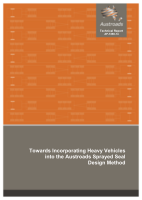Pavement

- Publication no: AP-T260-14
- ISBN: 978-1-925037-51-7
- Published: 20 February 2014
- PDF (free) Download
There has been a continual increase in the number of large heavy vehicles nationwide since the review of the Austroads sprayed seal design method in 2001. This report aims to refine the traffic adjustment factor by updating and reanalysing the loading effect of heavy vehicles on the seal surfacings. Two seal design factors for heavy vehicles are devised: damage factor (DF) and equivalent heavy vehicle based on the definition that a Class 4 (3 axle truck) was the standard vehicle (EHVDF) (cf. existing definition of EHV that is based on the annual average daily traffic data). A total of 126 million weight-in-motion (WIM) data from the rural regions obtained during the period from 2007 to 2011 were provided by Australian jurisdictions.
The analysis process used in the report could be adapted to data derived from specific locations or across a particular state. A proportional distribution of vehicle fleet composition was derived from the WIM data for each jurisdiction. DF and EHVDF for each vehicle class in relation to a Class 4 vehicle were also derived for each jurisdiction.
- 1. Introduction
- 1.1. Background
- 1.2. Aims
- 2. Sprayed Seal Design Method
- 2.1. Sprayed Seal Design Concept
- 2.1.1. Equivalent Heavy Vehicle (EHV)
- 2.2. Proposed Seal Design Factors for Heavy Vehicle Classes
- 2.2.1. Damage Factor (DF)
- 2.2.2. Equivalent Heavy Vehicle based on Damage Factor (EHVDF)
- 3. Weigh-in-Motion Data and Methodology
- 3.1. Weigh-in-Motion (WIM) System
- 3.1.1. Accuracy of WIM System
- 3.1.2. Scope of WIM Data Collection
- 3.1.3. WIM Sites Location
- 3.2. Data Analysis
- 3.2.1. Database
- 3.2.2. Data Processing
- 3.2.3. Assumptions
- 4. Results and Discussion
- 4.1. Overview of WIM Data
- 4.2. Fleet Composition
- 4.2.1. Trend of Fleet Composition with Time
- 4.3. Vehicle Mass
- 4.3.1. Introduction
- 4.3.2. Trends in Mean Mass with Time
- 4.4. Seal Design Factors for Heavy Vehicle Classes
- 4.4.1. Comparison of Damage Factor (DF) per Vehicle Class
- 4.4.2. Comparison of Equivalent Heavy Vehicle based on Damage Factor (EHVDF) per Vehicle Class
- 4.4.3. Summary
- 5. Light Vehicles
- 6. Summary
- 6.1. Findings
- 6.2. Suggestions
- 7. Conclusions
- References
- Appendix A WIM Sites Location
- A.1 New South Wales (NSW)
- A.2 Northern Territory (NT)
- A.3 Queensland (QLD)
- A.4 South Australia (SA)
- A.5 Tasmania (TAS)
- A.6 Victoria (VIC)
- A.7 Western Australia (WA)
- Appendix B Heavy Vehicles Distribution: State by State
- Appendix C Heavy Vehicle Distribution: Average of Annual Fleet Composition, Mass Loading and Damage Factor
- Appendix D Sample Calculations for Seal Design Factors
- D.1 Damage Factor (DF)
- D.2 Equivalent Heavy Vehicle based on Damage Factor (EHVDF)
